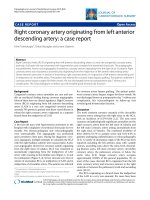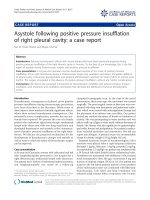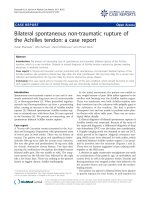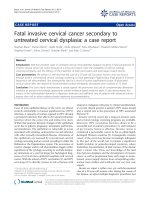Báo cáo y học: "Granulomatous cheilitis associated with exacerbations of Crohn''''s disease: a case report" potx
Bạn đang xem bản rút gọn của tài liệu. Xem và tải ngay bản đầy đủ của tài liệu tại đây (449.04 KB, 4 trang )
BioMed Central
Page 1 of 4
(page number not for citation purposes)
Journal of Medical Case Reports
Open Access
Case report
Granulomatous cheilitis associated with exacerbations of Crohn's
disease: a case report
John K Triantafillidis*
1
, Flora Zervou Valvi
2
, Emmanouel Merikas
1
,
George Peros
3
, Ourania Nicolatou Galitis
4
and Aristofanis Gikas
5
Address:
1
Department of Gastroenterology, "Saint Panteleimon" General Hospital, Nikea, Greece,
2
Department of Oral Medicine, "Saint
Panteleimon" General Hospital, Nikea, Greece,
3
Fourth Surgical Department, University of Athens, Athens, Greece,
4
Oral Pathology and Medicine
Department, School of Dentistry, University of Athens Greece and
5
Health Center of Kalivia, Attica, Greece
Email: John K Triantafillidis* - ; Flora Zervou Valvi - ;
Emmanouel Merikas - ; George Peros - ; Ourania Nicolatou Galitis - ;
Aristofanis Gikas -
* Corresponding author
Abstract
Introduction: Crohn's disease is a disease involving the whole gastrointestinal tract from the
mouth to the anus. Oral lesions are considered to be an important extraintestinal manifestation.
Granulomatous cheilitis has been recognized as an early manifestation of Crohn's disease. It may
follow, coincide with or precede the onset of Crohn's disease. The aim of this presentation is to
describe a rare case of a patient with Crohn's disease in whom significant swelling of the lower lip
not only preceded the diagnosis of Crohn's disease for two years, but it manifested as an early
clinical index of the recurrence of the intestinal disease as well.
Case presentation: A man aged 25 was admitted in our department on August 1999 with chronic
diarrhea and loss of weight. His bowel symptoms started in 1998 at the age of 24. However, two
years previously (June 1996) he noticed a swelling of the lower lip, which contrasted significantly
with the previously normal appearance of his mouth. A lip biopsy performed at that time was
compatible with granulomatous cheilitis. Crohn's disease involving the terminal ileum and large
bowel was diagnosed in 1998 and confirmed on the basis of colonoscopy, enteroclysis and histology
findings of the small and large bowel. Conservative treatment resulted in clinical and laboratory
improvement of the bowel symptoms and lip swelling. During the following years the disease was
active with exacerbations and remissions of mild to moderate severity. The swelling of the lower
lip occurred in parallel with the exacerbations of the bowel disease, returning to normal during
periods of remission.
Conclusion: Significant swelling of the lower lip due to granulomatous cheilitis could be the first
manifestation of Crohn's disease, preceding intestinal symptoms. Exacerbation of the lip lesion
could be an early clinical sign of a relapse of the underlying intestinal disease.
Introduction
Oral lesions are well-documented clinical features in
patients with Crohn's disease (CD) [1-4]. The spectrum of
these lesions described so far in the medical and dental lit-
Published: 25 February 2008
Journal of Medical Case Reports 2008, 2:60 doi:10.1186/1752-1947-2-60
Received: 2 May 2007
Accepted: 25 February 2008
This article is available from: />© 2008 Triantafillidis et al; licensee BioMed Central Ltd.
This is an Open Access article distributed under the terms of the Creative Commons Attribution License ( />),
which permits unrestricted use, distribution, and reproduction in any medium, provided the original work is properly cited.
Journal of Medical Case Reports 2008, 2:60 />Page 2 of 4
(page number not for citation purposes)
erature is quite large and includes oral ulceration, labial,
buccal and gingival swelling, buccal abscesses, mucosal
inflammatory hyperplasia, mucosal tags and fissuring,
gingivitis, granulomatous inflammation of minor salivary
glands, granulomatous cheilitis [5-10], candidiasis, angu-
lar cheilitis, lichen planus, pyostomatitis vegetans, lym-
phadenopathy, perioral erythema, orofacial
granulomatosis, midline lip fissuring, cobblestone
appearance of the mucosa, and dental caries. The preva-
lence of oral lesions in newly diagnosed patients has been
estimated to be up to 48% [1].
It is of interest that, like other extraintestinal manifesta-
tions, oral lesions may precede the onset of the underlying
intestinal inflammatory disorder [3,7,8]. However, it is
difficult to determine exactly which oral manifestation is
certainly related to CD although it is logical to hypothe-
size that some of these lesions are in fact consequence of
the disease or a secondary reaction to medical treatment.
Orofacial granulomatosis is a term used to describe swell-
ing of the orofacial area, mainly the lips, secondary to an
underlying granulomatous inflammatory process. Granu-
lomatous cheilitis is the histopathological description of
such inflammation occurring in the lips and surrounding
tissues [5,8,9]. It has been recognized as an early manifes-
tation of CD following, coinciding with or preceding the
onset of CD [7,8]. This extraintestinal manifestation could
significantly affect the quality of life of patients with CD.
Therefore, the aim of this presentation is to describe the
long-term clinical course of the underlying CD in relation
to the clinical behavior of the oral lesion in different time
periods.
Case presentation
The patient was a man aged 25. He was a smoker (20 cig-
arettes per day) since the age of 19. His symptoms started
on June 1998 at the age of 24, with chronic diarrhea not
accompanied by mucus or blood in the stools, abdominal
pain, fever, or loss of weight. Two years previously on June
1996, he had noticed a slight swelling of the lower lip
which contrasted with the previously normal appearance
of his mouth (Figure 1). He consulted a specialist in oral
medicine, who performed a lip biopsy. The histology of
the specimen (13 × 7 × 7 mm) showed a multilayer squa-
mous epithelium covering the tissue specimen, scattered
clusters of lymphocytes and histiocytes resembling non-
caseating granulomas, as well as infiltration of the small
vessel walls of the underlying connective tissue by mono-
cytes (Figure 2). The diagnosis was compatible with gran-
ulomatous cheilitis. Colonoscopy performed in 1998
revealed large ulcers in the terminal ileum and caecum.
Enteroclysis confirmed the involvement of the terminal
ileum in a total length of 50 cm. Administration of meth-
ylprednisolone, mesalazine and cholestyramine, resulted
in prompt improvement of clinical symptoms and labora-
tory abnormalities.
During the subsequent years the disease course included
at least two clinically evident recurrences of moderate
severity that responded well to the administration of cor-
ticosteroids and mesalazine. Six years after diagnosis a
new recurrence of CD of moderate severity (CDAI 226
Histological picture of the patient's lip before the diagnosis of Crohn's diseaseFigure 2
Histological picture of the patient's lip before the
diagnosis of Crohn's disease. Multilayer squamous epi-
thelium covering the tissue specimen, scattered clusters of
lymphocytes and histiocytes resembling non-caseating granu-
lomas, and infiltration of the small vessel walls of the underly-
ing connective tissue by monocytes are seen.
Lip swelling before the appearance of bowel symptoms (June 1996)Figure 1
Lip swelling before the appearance of bowel symp-
toms (June 1996).
Journal of Medical Case Reports 2008, 2:60 />Page 3 of 4
(page number not for citation purposes)
points) was noticed, accompanying by lip swelling as well
(Figure 3). Enteroclysis and colonoscopy plus ileoscopy
showed active disease confined to the terminal ileum and
the cecum.
The characteristic of the clinical course of the patient was
the fact that during the exacerbations of CD, the enlarge-
ment of the lip was more evident, returning to almost nor-
mal during the periods of remission and that the
administration of corticosteroids resulted in prompt
improvement of the lip swelling.
Discussion
Orofacial granulomatosis is a term generally used to
describe swelling of the orofacial area, mainly the lips, sec-
ondary to an underlying granulomatous inflammatory
process. It is a heterogeneous clinical condition that
presents with chronic swelling of the oral or facial tissues
due to granulomatous inflammation. Granulomatous
cheilitis is a very rare disorder of unknown etiology, char-
acterised by recurrent swelling of the labial tissues. The
typical histological picture is the formation of scattered
aggregates of non-caseating granulomas and epithelioid
histiocytes. Melkersson-Rosenthal syndrome (a triad of
orofacial swelling, facial paralysis and a fissured tongue)
is one manifestation of orofacial granulomatosis, which
more commonly presents as granulomatous cheilitis
alone [5-10]. Most reported cases of orofacial granuloma-
tosis have been in adults and some in adolescents. Orofa-
cial granulomatosis in the paediatric population may be
an initial manifestation of CD.
The interesting points regarding the clinical manifesta-
tions and the course of our patient were the fact that gran-
ulomatous cheilitis preceded the diagnosis of CD by two
years, the fact that the enlargement of the lower lip
occurred in parallel with the clinical exacerbations of CD
and that the administration of corticosteroids resulted not
only in improvement of bowel symptoms but also in
diminishment of the size of the lip swelling. Another
point of interest was the fact that granulomatous cheilitis
was the only extraintestinal manifestation in our patient,
a fact not mentioned in other descriptions.
It has been suggested that histological oral inflammation
could be more common in patients with active than inac-
tive disease [6]. According to a relevant description,
patients with active CD tended to have higher scores of
gingivitis than patients with inactive disease. It has also
been found that smoking habit – a well established risk
factor for the development of CD – and duration of dis-
ease do not have any influence on the incidence of this
lesion in patients with inflammatory bowel disease.
The etiology of this lesion is unknown although various
factors including levels of vitamins and trace elements,
other nutritional components, and certainly the underly-
ing inflammatory bowel disease could be involved. Myco-
bacterium paratuberculosis has not been found to be
implicated in the pathogenesis of orofacial granulomato-
sis or oral CD as was suggested previously. In the absence
of mechanical irritation or other mucosal disease, the oral
lesions in CD could be attributed to the inflammatory
bowel disease itself. It is of interest that patients with oral
lesions have a significantly higher proportion of involve-
ment of the upper gastrointestinal tract (esophagus) with
CD [3,5].
Concerning treatment of granulomatous cheilitis and oral
lesions of inflammatory bowel disease patients in general,
it seems that topical application of corticosteroids, in con-
junction with systemic treatment of the bowel disease,
could be of benefit as seen in our patient [9].
This case emphasizes the fact that orofacial granulomato-
sis may be misdiagnosed since its clinical manifestations
may be independent of or even precede the appearance of
CD. Thus, patients with possible granulomatus cheilitis
should be carefully asked about the presence of gastroin-
testinal symptoms. Those with suspicious symptoms
should have a careful gastrointestinal evaluation, includ-
ing enteroclysis or imaging capsule as well as complete
gastrointestinal endoscopic examination. Once granulo-
matus cheilitis is diagnosed the patient should be fol-
lowed up carefully and investigated for CD when
gastrointestinal symptoms develop [6]. However, not all
authors agree completely with this assumption. Van der
Waal et al found a low chance of developing CD in their
patients with granulomatus cheilitis and thus they suggest
Oral lesion during exacerbation of Crohn's disease (July 2005)Figure 3
Oral lesion during exacerbation of Crohn's disease
(July 2005).
Publish with BioMed Central and every
scientist can read your work free of charge
"BioMed Central will be the most significant development for
disseminating the results of biomedical research in our lifetime."
Sir Paul Nurse, Cancer Research UK
Your research papers will be:
available free of charge to the entire biomedical community
peer reviewed and published immediately upon acceptance
cited in PubMed and archived on PubMed Central
yours — you keep the copyright
Submit your manuscript here:
/>BioMedcentral
Journal of Medical Case Reports 2008, 2:60 />Page 4 of 4
(page number not for citation purposes)
that patients with a negative history of gastrointestinal
complaints should not be exposed to routine investiga-
tions of the gastrointestinal tract [9].
Conclusion
From the clinical course of this patient we suggest that
granulomatous cheilitis manifesting as a significant swell-
ing of the lower lip could be the first clinical sign of CD.
This lesion could well be correlated with the activity of the
intestinal disease, being quite prominent in periods of
exacerbation of CD and retuning to almost normal
appearance during periods of remission.
Competing interests
The author(s) declare that they have no competing inter-
ests.
Authors' contributions
JKT drafted the paper; the patient was under his medical
diagnostic and therapeutic care. FZV reviewed the histol-
ogy of the lip, examined the patient, defined the exact
nature of the lesion and made substantial contribution to
the discussion. EM and GP critically revised the whole
paper and made important suggestions. ONG reviewed
the initial histology of lip and made substantial contribu-
tion to the discussion. AG contributed to the acquisition
and interpretation of data and drafted the manuscript. All
authors read and approved the final manuscript.
Consent
Written informed consent was obtained from the patient
for publication of this case report and accompanying
images. A copy of the written consent is available for
review by the Editor-in-Chief of this journal.
References
1. Zervou F, Gikas A, Merikas E, Peros G, Sklavaina M, Loukopoulos J,
Triantafillidis JK: Oral lesions in patients with inflammatory
bowel disease. Ann Gastroenterol 2004, 17:395-401.
2. Halme L, Meurman JH, Laine P, von Smitten K, Syrjanen S, Lindqvist
C, Strand-Pettinen I: Oral findings in patients with active or
inactive Crohn's disease. Oral Surg Oral Med Oral Pathol 1993,
76:175-181.
3. Plauth M, Jenss H, Meyle J: Oral manifestations of Crohn's dis-
ease. An analysis of 79 cases. J Clin Gastroenterol 1991, 13:29-37.
4. Field EA, Tyldesley WR: Oral Crohn's disease revisited – a 10-
year review. Br J Oral Maxillofacial Surg 1989, 27:114-123.
5. Kolokotronis A, Antoniades D, Trigonidis G, Papanagiotou P: Gran-
ulomatous cheilitis: a study of six cases. Oral Dis 1997,
3:188-192.
6. Sciubba JJ, Said-Al-Naief N: Orofacial granulomatosis: presenta-
tion, pathology and management of 13 cases. J Oral Pathol Med
2003, 32:576-585.
7. Bogenrieder T, Rogler G, Vogt T, Landthaler M, Stolz W: Orofacial
granulomatosis as the initial presentation of Crohn's disease
in an adolescent. Dermatology 2003, 206:273-278.
8. Ahmad I, Owens D: Granulomatus cheilitis and Crohn's dis-
ease. Can J Gastroenterol 2001, 15:273-275.
9. van der Waal RI, Schulten EA, van der Meij EH, van de Scheur MR,
Starink TM, van der Waal I: Cheilitis granulomatosa: overview of
13 patients with long-term follow-up – results of manage-
ment. Int J Dermatol 2002, 41:225-229.
10. Meurman JH, Halme L, Laine P, von Smitten K, Lindqvist C: Gingival
and dental status, salivary acidogenic bacteria, and yeast
counts of patients with active or inactive Crohn's disease.
Oral Surg Oral Med Oral Pathol 1994, 77:465-468.









